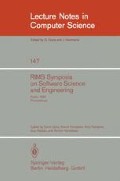Abstract
Object oriented programming languages and the computer architecture to support the reliable and efficient execution of programs written in these languages are important issues for providing better programming environment. The main purpose of this paper is to establish the foundation for the design and implementation of object oriented programming languages and object oriented architecture. First, various definitions for object in existing languages and systems are surveyed. Then a new model of object and computation on objects is introduced to establish the foundation. A new object oriented language is used both to rationalize the model and to exemplify how the model is applied to object oriented languages. Finally, issues in the design and implementation of an object oriented architecture which directly reflects this model is described.
Preview
Unable to display preview. Download preview PDF.
References
Reference Manual for the Ada Programming Language, United States Department of Defense, 1980.
Baroody Jr., A.J. and DeWitt, D.J., "An Object-Oriented Approach to Database System Implementation," ACM Trans. on Database Systems, Vol. 6, No. 4, Dec. 1981.
Bobrow, D.G. and Winograd, T., "An Overview of KRL, a Knowledge Representation Language," CSL-76-4, Xerox PARC, July 1976.
Borning, A.H. and Ingalls, D.H.H., "A Type Declaration and Inference System for Smalltalk," Proc. of Principle of Programming Languages, December 1981.
Codd, E.F., "Relational Database: A Practical Foundation for Productivity," CACM, Vol. 25, No. 2, Feb. 1981.
Date, C.J., "An Introduction to Database Systems," Third Ed., Addison Wesley, 1981.
Denning, P.J., "Fault Tolerant Operating Systems," Computing Surveys, Vol. 8, No. 4, pp.359–389, 1976.
England, D.M., "Architectural Feature of System 250," Infotech State of the Art Report 14: Operating Systems, Berkshire, Infotech, England, pp.395–428, 1972.
Feldman, J.A., "High Level Programming for Distributed Computing," Communications of ACM, Vol.22, No.6, pp.353–368, 1979.
Feustel, E.A., "The Rice Research Computer — A tagged Architecture," AFIPS SJCC, pp.369–377, 1972.
Giloi, W.K. and Berg, H.K., "Data Structure Architecture — A Major Operational Principle", Proc. of 5th Annual Symposium on Computer Architecture, 1978.
Goldberg, A. and Kay, A., ed., "Smalltalk-72 Instruction Manual," Xerox Palo Alto Research Center, March 1976.
Goldstein, Ira and Bobrow, Daniel, "An Experimental Description-Based Programming Environment: Four Reports," Xerox PARC Research Report, CSL-81-3, March 1981.
Goto, E, Ida, T, and Gunji, T, "Parallel Hashing Algorithms," Information Processing Letters, Vol. 6, No. 1, 1977.
Hewitt, C., et al., "A Universal Modular Actor Formalism for Artificial Intelligence," Proc. of IJCAI, pp.235–245, 1973.
Hewitt, C., "Viewing Control Structures as Patterns of Passing Messages," J. of Artificial Intelligence, Vol. 8, 1977.
Hoevel, L.W. and Flynn, M.J., "The Structure of Directly Executed Languages: A New Theory of Interpretive System Design," TR-130, Digital Systems Laboratory, Stanford University, 1977.
Houdek, M.E, Soltis, F.G., and Hoffman, R.L, "IBM System/38 Support for Capability-Based Addressing," Proc. of the 8th Int'l Symp. on Computer Architecture, pp.341–348, May 1981.
"IBM System/38 Technical Developments (G58060237)," IBM, 1980.
Iliffe, J.K., "Basic Machine Principles," American Elsevier, New York, 1968.
"Intel APX432 General Data Processor Architecture Reference Mannual," Intel, Aloha, Orengon, 1981.
Kahn, K.C., et al., "iMAX: A Multiprocessor Operating System for an Object-Based Computer," Proc. of the Eighth Symp. on Principles of Operating Systems, Dec. 1981.
Liskov, B., et al., "CLU Reference Manual," TR-225, Laboratory for Computer Science, MIT, Oct. 1979.
Myers, G.J., and Buchinghan, B.R.S., "A Hardware Implementation of Capability-Based Addressing," Computer Architecture News, Vol. 8, No. 6, 1980.
Myers, G.J., "Advances in Computer Architecture", Second Ed., John Wiley and Sons, 1982.
Patterson, D.A., and Sequin, C.H., "RISC-I: A Reduced Instruction Set VLSI Computer," Proc. of the 8th Int'l Symp. on Computer Architecture, pp.443–457, May 1981.
Radin, G, "The 801 Minicomputer," Proc. of the Symp. on Architectural Support for Programming Languages and Operating Systems, pp.39–47, March 1982.
Rattner, J. and Cox, G., "Object-Based Computer Architecture," Computer Architecture News, Vol. 8, No. 6, 1980.
Snyder, A., "A Machine Architecture to Support an Object-Oriented Language," MIT TR-209, Laboratory for Computer Science, MIT, Marach 1979.
Suzuki, N., "Inferring Types in Smalltalk," Proc. of Principle of Programming Languages, December 1980.
Tokoro, M and Takizuka, T., "On the Semantic Structure of Information — A Proposal of the Abstract Storage Architecture," Proc. of the 9th Int'l Symp. on Computer Architecture, pp.211–217, April 1982.
Williams, G., "Program Checking", Sigplan Notice, Vol. 14, No. 9, pp.13–25, 1979.
Wilner, W.T., "Burroughs B1700 Memory Utilization," AFIPS FJCC, 1972.
Wulf, W.A., et al., "Overview of the Hydra Operating System," Proc. of the 5th Symposium on Operating System Principles, pp.122–131, Nov. 1975.
Wulf, W.A., Levin, R., and Harbison, S.P., "HYDRA/C.mmp: An Experimental Computer System," McGraw-Hill, New York, 1981.
Xerox Learing Research Group, "The Smalltalk-80 System," Special Issue on Smalltalk-80 System, Byte, Vol. 6, No. 8, August 1981.
Yonezawa, A., "Unified model of Algorithm Representation," in "Algorithm Representation," Iwanami Book Co., (in Japanese,) 1981.
Yoshida, K., "A Research on Error Free Machines — A proposal of New Floating-Point Arithmetic based on Recurring Rationals," Computer Science Report, Arithmetic-82-1, Department of E. E., Keio University, March 1982.
Author information
Authors and Affiliations
Editor information
Rights and permissions
Copyright information
© 1983 Springer-Verlag Berlin Heidelberg
About this paper
Cite this paper
Tokoro, M. (1983). Toward the design and implementation of object oriented architecture. In: Goto, E., Furukawa, K., Nakajima, R., Nakata, I., Yonezawa, A. (eds) RIMS Symposia on Software Science and Engineering. Lecture Notes in Computer Science, vol 147. Springer, Berlin, Heidelberg. https://doi.org/10.1007/3-540-11980-9_15
Download citation
DOI: https://doi.org/10.1007/3-540-11980-9_15
Published:
Publisher Name: Springer, Berlin, Heidelberg
Print ISBN: 978-3-540-11980-7
Online ISBN: 978-3-540-39442-6
eBook Packages: Springer Book Archive

